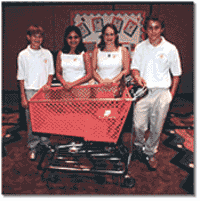 |

|
 |
 |
|
A nanocontact separating
two macroscopic electrodes of oposite magnetization. Electrons
passing through the nanocontact experience a huge scattering
moment.
Image courtesy: H.D. Chopra, SUNY-Buffalo.
|
Data Storage Gets Ultrasmall with Remarkable Breakthrough in Electrical Resistance
Two materials researchers have developed an extremely sensitive nanoscale device that could shrink ultra-high-density storage devices to record sizes. The magnetic sensor, made of nickel and only a few atoms in diameter, could increase data storage capacity by a factor of a thousand or more and could ultimately lead to supercomputing devices as small as a wristwatch. The National Science Foundation (NSF) supported the research.
More...
(posted July 5, 2002)
|
 |
|
 |
A schematic illustration of a gamma-ray burst in progress.
Image courtesy: Caltech/Jonathan Williams |
Astrophysicist Traces Gamma Rays, Receives Astronomy Honor
An NSF-supported astrophysicist has identified explosions from dying stars as the source of some gamma-ray bursts. For years astronomers have sought to confirm the cosmic source of the mysterious gamma rays. The bursts have been detected for 30 years but little is known about them. Now, Shri Kulkarni of the California Institute of Technology and colleagues have tied a gamma-ray burst directly to a supernova, or exploding massive star.
More...
(posted July 5, 2002)
|
 |
|
Scientists Can Help Battle Terrorism, NSF Director Urges
NSF Director Rita Colwell urged scientists to apply their experience, wisdom, research and measured debate to help the nation combat terrorism in a June 19 speech to the Brookings Institution's Center for Public Policy Education. Noting that the "new era marked by the watershed events of 9/11 presents new directions for science and technology," Colwell called on scientists to help improve predictions and to apply their foresight as "a kind of early warning system-a guard against unintended consequences."
More... (posted
July 5, 2002)
|
 |
|
 |
| Graphic developed (evolved) from original
graphic by J.J.Sepkoski, Jr. |
Bayer/NSF Award Winners Tackle Runaway Shopping Carts, Wheelchair Accidents, Infant Deaths in Cars, and a Serious Environmental Threat to Lakes
Some of the nationís most innovative middle school students were named Columbus Foundation Community Grant and Bayer/National Science Foundation Award winners on June 20 for their ideas to solve important community issues. The students' ideas included a braking system to prevent runaway shopping carts, a braking system to slow wheelchairs on slopes, a baby beeper to prevent children from being left in cars, and an environmental action plan to stop the spread of the Eurasion water milfoil, an 'aquatic exotic' that is choking lakes in 45 states across the U.S.
More... (posted
July 5, 2002)
|


|

